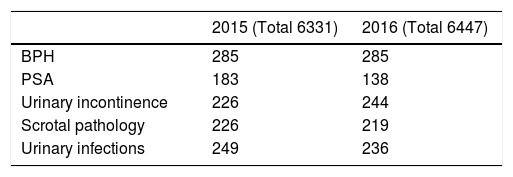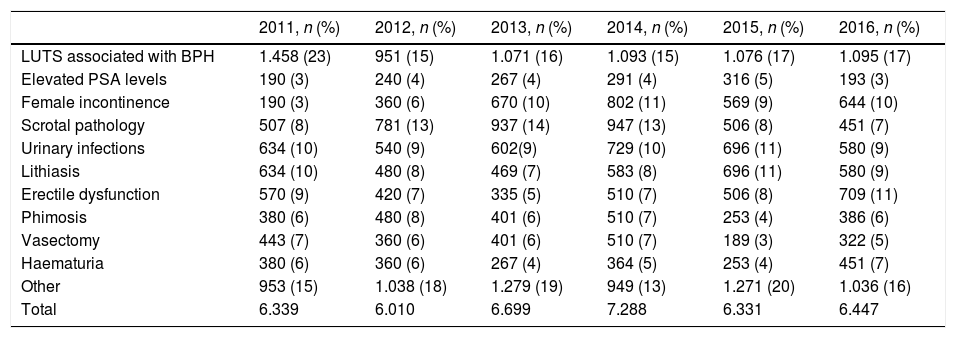To analyse the evolution and adequacy of referrals from primary care to urology, after the implementation of referral protocols on the most frequent urological diseases and the establishment of a continuing education program.
Material and methodsA primary care-urology work group was created in 2011. Initially, performance and clinical practice protocols in prostatic pathology (BPH and PSA) were established. These were supported by training sessions for primary care physicians.
After analysing the effect of the mentioned joint work, 3 more protocols (scrotal pathology, urinary tract infections and urinary incontinence) were included. We analysed and compared the referrals and their adequacy before and after the establishment of the protocols.
ResultsThe most common referral causes were symptoms of the lower urinary tract due to BPH, which initially represented 22.8% of the total, and decreased to 16.9%. After the introduction of the new algorithms, we observed a decrease in referrals for scrotal pathology (13–14% to 7.8%), an increase in urinary incontinence referrals (3–10.3%) and those related to urinary tract infections remained stable. The adequacy to the protocols improved progressively: LUTS from 46% to 65.3%; PSA from 55% to 84.4% and urinary incontinence from 66.2% to 73.1%.
Adequacy in scrotal pathology decreased (67.1% to 63.3%), while in UTI it stayed much the same (around 76%).
ConclusionsThe joint work between Urology and Primary Care achieves an improvement in referrals adequacy regarding the most frequent urological pathologies.
Analizar la evolución y adecuación de las derivaciones de Atención Primaria a Urología tras la implantación de protocolos sobre las enfermedades urológicas más frecuentes y la instauración de un programa de formación continuada.
Material y métodosEn el 2011 se creó un grupo de trabajo Atención Primaria-Urología. Se instauraron inicialmente protocolos de actuación y práctica clínica en enfermedad prostática (HBP y PSA), que se apoyaron con sesiones formativas a los médicos de Atención Primaria. Tras analizar su efecto, en el 2015 se añadieron otros 3(enfermedad escrotal, infecciones urinarias e incontinencia urinaria). Analizamos y comparamos las derivaciones y su adecuación antes y después de la instauración.
ResultadosEl motivo más frecuente de derivación son los síntomas del tracto urinario inferior (STUI) por HBP que, inicialmente, suponían un 22,8% del total, y que han disminuido al 16,9%. Tras la introducción de los demás algoritmos, observamos una disminución de las derivaciones sobre enfermedad escrotal (del 13-14 al 7,8%), que permanecen estables (en torno al 10%) las relacionadas con infecciones urinarias y que aumentan las derivaciones por incontinencia urinaria (del 3 al 10,3%). La adecuación a los protocolos fue mejorando progresivamente en las relacionadas con STUI (del 46 al 65,3%); en PSA (del 55 al 84,4%) y en incontinencia urinaria (del 66,2 al 73,1%). Descendió la adecuación en cuanto a enfermedad escrotal (del 67,1 al 63,3%) y se mantuvo similar en ITU (en torno al 76%).
ConclusionesEl trabajo conjunto entre Urología y Atención Primaria consigue mejorar la adecuación de las derivaciones en las enfermedades urológicas más frecuentes.












